West Coast Swing
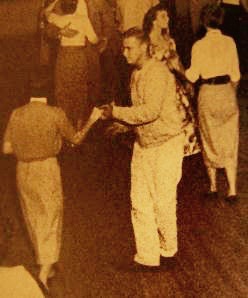
http://en.wikipedia.org/wiki/West_Coast_Swing
Generational Swing – Snapshots of West Coast Swing before the 1990’s
West Coast Swing as a dance remained intact until around the year 2000, where it slowly started to develop into another dance with different rules. Unfortunately, many of our “new” instructors of the last 10 years have claimed that the dance has always changed in order to fit the Top 40 songs of the day. This video shows clips that prove the opposite. West Coast Swing has embodied the “Swing Essentials” listed in my article for decades since it’s inception,no matter what the music. Thank you to all who have posted these videos individually online. I encourage everyone to post their own historical WCS videos from all eras in order to preserve and educate our new dancers… and enable the other dance to let go and form it’s own culture without destroying ours. Visit www.wcskat.blogspot.com for more articles and videos, or www.wcskat.com for more info! Happy Dancing!
 Dancing to musicians wearing cowboy hats and string ties playing fiddle, steel guitar, etc. Pumpkin Center, Bakersfield, CA 1950’s
Dancing to musicians wearing cowboy hats and string ties playing fiddle, steel guitar, etc. Pumpkin Center, Bakersfield, CA 1950’s
West Coast Swing (WCS) is a partner dance with roots in Lindy Hop. It is characterized by a distinctive elastic look that results from its basic extension-compression technique of partner connection, and is danced primarily in a slotted area on the dance floor. The dance allows for both partners to improvise steps while dancing together, putting West Coast Swing in a short list of dances that put a premium on improvisation.
Typically the follower walks into new patterns traveling forward on counts “1” and “2” of each basic pattern, rather than rocking back. Traditional figures include 6-count and 8-count patterns of one of the four basic varieties: (1) Starter Step, (2) Side Pass, (3) Push Break / Sugar Push, (4) Whip. The Anchor Step is a common ending pattern of many West Coast Swing figures.
History
It is believed that the origins of the WCS are in Lindy Hop. In a 1947 book, Arthur Murray recognized that, “There are hundreds of regional dances of the Jitterbug type. Each section of the country seems to have a variation of its own.”
Dean Collins, who arrived in the Los Angeles area around 1937, was influential in developing the style of swing danced on the West Coast of the United States, as both a performer and teacher. When his wife, Mary Collins, was asked if Dean was responsible for the emergence of the dance, however, she said that Dean insisted there were “only two kinds of swing dance – good and bad.”
Lauré Haile, Arthur Murray National Dance Director, and an instructor of teachers documented swing dancing as done in the Los Angeles area and used the name “Western Swing”. Murray had used the same name, “Western Swing”, in the late 1930’s for a different dance. Haile included Western Swing in Dance Notebooks she authored for Arthur Murray during the 1950’s. Western Swing was also called “Sophisticated Swing” in the 1950’s.
 Western swing, country boogie, and, with a smaller audience, jump blues were popular on the West Coast throughout the 1940’s and into the 1950s when they were renamed and marketed as rock ‘n’ roll in 1954. Dancers danced “a ‘swingier’ – more smooth and subdued” form of Jitterbug to Western Swing music.
Western swing, country boogie, and, with a smaller audience, jump blues were popular on the West Coast throughout the 1940’s and into the 1950s when they were renamed and marketed as rock ‘n’ roll in 1954. Dancers danced “a ‘swingier’ – more smooth and subdued” form of Jitterbug to Western Swing music.
West Coast Swing (still known as Western Swing at that time) is the basis for the dancing in the rehearsal scene in “Hot Rod Gang” (1958). Music is supplied by rockabilly musician Gene Vincent’s “Dance to the Bop.” The song alternates between very slow sections and those with the rapid pace and high energy of rockabilly. Staged by a young Dick Di Augustin, the dancing includes recognizable patterns such as the chicken walk, swing out from closed position, etc., along with the classic woman’s walk walk triple step triple step at the end of the slot. On the final step of the second triple the women are weighted left with the right heel on the floor and the toes pointed up. Dancers also do classic Lindy flips at the end of the slot, as well as non partner, non West Coast Swing movements.
Murray’s taught Western Swing beginning from a closed position and the possibility of dancing single, double, or triple rhythm. After a “Throwout” patterns began with the woman “walking in” and the man doing a “rock step,” or step together for counts one and two. Although the dance remained basically the same, the Golden State Dance Teachers Association (GSDTA) began teaching from the walk steps, counts 1 and 2. It replaced Lauré Haile’s Coaster Step with an “Anchor Step” around 1961.
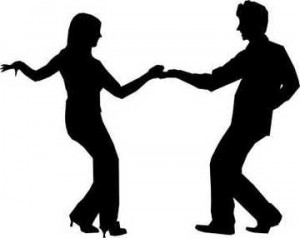 “West Coast swing” as a synonym for “Western swing” appears in a 1961 dance book, and was used in an advertisement by Skippy Blair in 1962. But wasn’t incorporated into mainstream swing circles until the late 1960’s.
“West Coast swing” as a synonym for “Western swing” appears in a 1961 dance book, and was used in an advertisement by Skippy Blair in 1962. But wasn’t incorporated into mainstream swing circles until the late 1960’s.
Blair credits Jim Bannister, editor of the Herald American newspaper in Downey, for suggesting the name West Coast Swing. When the Golden West Ballroom, in Norwalk, California, changed from Country to Ballroom dancing, the dance most advertised on the Marquee was West Coast Swing.
Western Swing was documented in the 1971 edition of the “Encyclopedia of Social Dance”. Patterns began with the woman stepping forward twice, but described the “Coaster Step” with a forward step as the last step of the 2nd triple. The one song that was listed for this dance was “Comin’ On” by Bill Black‘s Combo (1964 Hi #2072). As late as 1978, the term “Western Swing” was common usage among Chain and Independent Studios to describe “slotted swing”.
Circa 1978 “California Swing” was yet another name for West Coast Swing, albeit with styling that was “considered more UP, with a more Contemporary flavor.” By 1978 GSDTA had “some 200 or more patterns and variations” for West Coast Swing.”
In 1988, West Coast Swing was pronounced the Official State Dance of California.
Slot
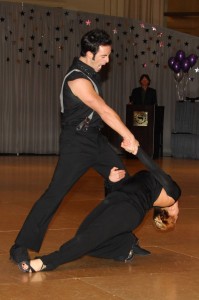 West Coast Swing is a slotted dance. The slot is an imaginary area, long and thin, eight or nine feet long if danced at a very slow Tempo, but shorter if the music is at a faster tempo. The follower travels back and forth in the slot dancing straight through the lead. The leader consistently moves a minimum amount (at mid-way point) to his sides, barely out of her way. She lightly brushes against him each time she passes him. Brushing seems rare these days though (2009).
West Coast Swing is a slotted dance. The slot is an imaginary area, long and thin, eight or nine feet long if danced at a very slow Tempo, but shorter if the music is at a faster tempo. The follower travels back and forth in the slot dancing straight through the lead. The leader consistently moves a minimum amount (at mid-way point) to his sides, barely out of her way. She lightly brushes against him each time she passes him. Brushing seems rare these days though (2009).
Socially, it is considered good etiquette (particularly on a crowded floor) to use a fixed slot, in order to allow dancing without incident. Having danced the slot repeatedly, the couple “has a claim” on the area, and other couples usually cooperate and establish their own slot parallel with the dancers. If the dance floor is not crowded and the couple is afforded more space, such as during a competitive event, the dancers may move the slot around the floor more liberally.
There are urban myths regarding the origin of the slotted style. According to one version, it was an invention of Hollywood film makers who wanted “dancers to stay in the same plane, to avoid going in and out of focus.” Wide angle lenses with adequate depth of field for cinematography had in fact been available since the 1920’s. A variation on the “Hollywood film maker” theme is that film makers wanted “to avoid filming the backs” of dancers. A viewing of films featuring the work of Dean Collins in the 1940’s, and rock ‘n’ roll films made in the mid-1950s reveals the fact that dancers turn frequently and inevitably turn their backs to the camera. Although another unslotted swing dance, Balboa, became popular in the same area and under the same conditions, much has been made of “jitterbugging in the aisles” as a source of the slotted style.
Slotted moves were a common part of the step vocabulary of Lindy and/or Jitterbug dancers during the 1940s and 1950s. Rather than the walk, walk of West Coast Swing, however, two sets of triple steps were used when the woman moved down the slot, followed by a rock step rather than the current triple and anchor step.
Music
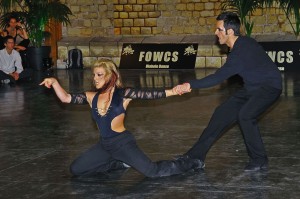 The origins of the dance that became known as West Coast Swing can be traced to the swing era. During this period many jazz, blues, and western musicians incorporated, or emphasized, the “swing” in their music. Writing in the “Arthur Murray Silver Dance Notebook,” Lauré Haile, who first described “Western Swing”, listed the following songs/records as “Good Swing or Fox Trot Records:”
The origins of the dance that became known as West Coast Swing can be traced to the swing era. During this period many jazz, blues, and western musicians incorporated, or emphasized, the “swing” in their music. Writing in the “Arthur Murray Silver Dance Notebook,” Lauré Haile, who first described “Western Swing”, listed the following songs/records as “Good Swing or Fox Trot Records:”
- “String of Pearls” by Glenn Miller (1942)
- “Let’s Dance” by Ray Anthony (Capitol L-258) (1951)
- “Be-Bop’s Spoken Here” by Les Brown Columbia 38499 (4/14/49)
“Also Good Swing – but unusual Chorus “AABA”:”
- “One Mint Julep“, Buddy Morrow, Victor 20-4869 (June/July 1952)
- “Dry Bones,” Tommy Dorsey, Victor 20-3523 (1949?)
Big Bands continued to flourish in the 1950s, touring, selling records, and appearing on radio and the new medium of television. As the decade wore on, however, many mostly younger listeners preferred to hear the simpler and (some say) noisier music given the name Rock ‘n’ Roll, and this music became known as the most popular music for dancing.
West Coast Swing-like moves can be seen in rock ‘n’ roll films made in that era. The film “Hot Rod Gang” shows West Coast Swing being done to the song “Dance to the Bop” by rockabilly musician Gene Vincent.
While teenagers preferred to freestyle dance through a constantly changing succession of discothèque social dance fads during the 1960’s, adults kept Swing alive.
Western Swing was documented in the 1971 edition of the “Encyclopedia of Social Dance”, listing the “Coaster Step” (with a forward step as the last step of the 2nd triple) rather than the Anchor Step. The one song that was listed for this dance was “Comin’ On” by Bill Black‘s Combo (1964 Hi #2072).
In the mid-1970s, disco music and dancing repopularized “touch” partner dancing, and, in California, West Coast Swing was one of the dances of the era. By the 1990’s country western dancers were dancing West Coast Swing to contemporary country western songs. West Coast Swing is now one of many dances done at country western venues.
In practice, West Coast Swing may be danced to almost any music in 4/4 time, and music of many different styles may be found in an evening of West Coast Swing dancing.
Styles
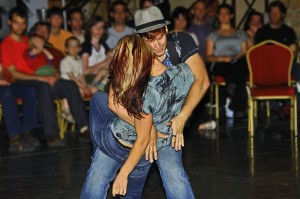 West Coast Swing can be danced to almost any music written in 4/4 time at speeds ranging from very slow to very fast; 15 to 45 Measures per Minute, ideally at 32 Measures per Minute (15×4=60 bpm, 32×4 = 128 bpm, 45×4=180 bpm). The character of the dance changes over that range. At the slowest speeds the dance tends to exhibit a highly elastic connection with the possibility of very sexy, “slinky” walks for the lady, and a slight backward leaning poise at the full extent of the connection. At faster speeds the partners become more upright and the connection shortens with more of a “push and pull” feel and look.
West Coast Swing can be danced to almost any music written in 4/4 time at speeds ranging from very slow to very fast; 15 to 45 Measures per Minute, ideally at 32 Measures per Minute (15×4=60 bpm, 32×4 = 128 bpm, 45×4=180 bpm). The character of the dance changes over that range. At the slowest speeds the dance tends to exhibit a highly elastic connection with the possibility of very sexy, “slinky” walks for the lady, and a slight backward leaning poise at the full extent of the connection. At faster speeds the partners become more upright and the connection shortens with more of a “push and pull” feel and look.
The “ideal” speed for WCS has been cited as 32 Measures per Minute (32×4 = 128 bpm), compared to advice to choose “records that are around 28 mpm” (28×4= 112 bpm) for “Western Swing.”
In writing about West Coast Swing, Skippy Blair advises that, “The only problem that exists in SWING is when someone decides there is only ONE WAY to dance it. There is never only ONE WAY to do anything …” “‘Try on’ different styles that you admire in other people…until you find the comfortable one that FITS YOU.”
Dancing to different types of music gives a different feel and look.
A 1998 summary of “trends” in West Coast Swing listed the following: Traditional/Classic with very little extension of the uncoupled arm, the man moving off and on the center of the track for most moves, and a heavy “couple weight”; Modern with more free arm extensions, and emphasis on how many spins, etc., the man can lead. Fast Music The man’s “couple hand” is fixed in space on beat 3 in a pass or push.
In 1994 Blair noted that the posture for men was more upright than in previous years.
Basic Guidelines
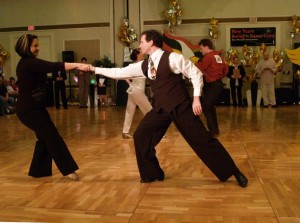 West Coast Swing is an evolving social dance that has gone through many changes throughout its short history, over time incorporating techniques from numerous dance styles. However, there are many guidelines that should be followed to maintain the true character of the dance. A dance’s character is typically defined by a basic philosophy, principles of movement, and traditional steps and figures. While these guidelines can be violated, by committing too many violations one risks departing from the defining features of the dance.
West Coast Swing is an evolving social dance that has gone through many changes throughout its short history, over time incorporating techniques from numerous dance styles. However, there are many guidelines that should be followed to maintain the true character of the dance. A dance’s character is typically defined by a basic philosophy, principles of movement, and traditional steps and figures. While these guidelines can be violated, by committing too many violations one risks departing from the defining features of the dance.
Philosophically, Modern West Coast Swing is in large part defined by an emphasis on Musicality and Connection. Movement is based on a principle borrowed from ballroom and Latin dance, in which the dancer moves their center of gravity immediately over the foot when a weight transfer is desired. Traditional figures include 6-count and 8-count patterns of one of the four basic varieties: (1) Starter Step, (2) Side Pass, (3) Push Break Sugar Push, (4) Whip. Many common WCS figures are derived from simple variations of these basic figures. West Coast swing is also a fundamentally improvised dance, and thus such defined figures are simply starting points for the skilled dancer.
Technical guidelines are as follows: Every figure or pattern should end with an anchor step, a critical characteristic feature of WCS. This is used to mark the end of a figure and re-establish connection between the two dancers. The leader should maintain the slot. The leader should use his own weight changes to lead the lady’s movement, not the arm or hand alone. The follower should continue to the end of the slot. The follower should assume a triple-step count unless led otherwise. Both closed and open positions are acceptable. A connection should be maintained at all times, using some combination of physical and visual connections. Most steps are danced in 2-beat groups, allowing 6-count and 8-count figures to be extended and shortened as necessary to fit the music. The leader should plan ahead in the dance to allow the follower to experience musical accents.
Although there are many exceptions and variations, the more traditional (1970’s) West Coast Swing guidelines are as follows:
- The follower will always start with the Right foot.
- The follower starts on a down beat, counts one or three of a measure.
- The follower has a rhythm pattern of six beats (to start): double (walk walk) a right triple and a left triple
- The follower will walk forward forward on the first two beats of every pattern.
- The follower will step 3 times at the end of each pattern, the Anchor Step.
- The leader will always start with the left foot.
- The leader will vary their first movement according to the location of their partner.
- The leader will vary step two depending on the direction of the pattern.
(Note that the follower’s step is different from the leader’s; partners do not mirror each other.)
A few basic moves that any WCS dancer should know are listed below. They are performed with the same “step step tri-ple-step tri-ple-step” pattern equalling eight steps in six beats of music. The term “count” is used as a synonym for a “beat,” usually a quarter note, of music.

